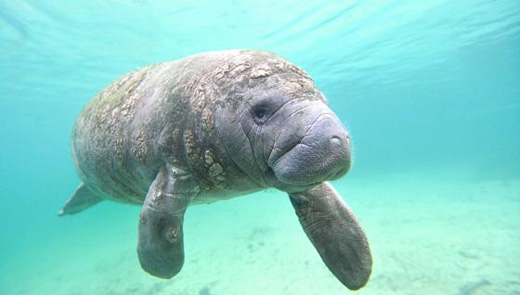
November is Manatee Awareness Month, a time to reflect on the gentle giants that are Florida’s official state marine mammal.
Yeah we’ve all heard the quip where people brag they have a swimmer’s body, and you reply, “Sure, so do manatees.”
But how much do you really know about this amazing animal?
Manatees comprise three of the four living species in the order Sirenia. The fourth is the Eastern Hemisphere’s dugong. Unlike the usual pattern of evolution of species from sea to land, Sirenia are believed to have evolved from four-legged land mammals over 60 million years ago. Their closest living relatives are elephants and hyraxes.
Mostly herbivorous, manatees spend a lot of time grazing on seagrasses in shallow warm water, and are sometimes referred to as sea cows. Florida manatees are endangered by human-made threats, so it’s especially important that people know more about them and what we can do to protect them. As Pope Francis reminds us, everything is connected.
The name manatí comes from the Taíno, a pre-Columbian people of the Caribbean. Manatee range is from the Mid-Atlantic states of the U.S. down to Florida, much of the Gulf of Mexico, the entire Caribbean, the Caribbean coast of Central America and the northern coast of South America. They measure up to 13 feet long, weigh as much as 1,300 pounds, and have paddle-like flippers. The females tend to be larger and heavier.
When born, baby manatees have an average mass of 66 pounds. They have a large, flexible prehensile upper lip used to gather food. Adults have no incisor or canine teeth, just a set of cheek teeth, which are not clearly differentiated into molars and premolars. These teeth are continuously replaced throughout life, with new teeth growing at the rear as older teeth fall out from farther forward in the mouth. This process, known as polyphyodonty, occurs among other mammals only in the kangarooand elephant. Females have two teats, one under each flipper,a characteristic that was used to make early links between the manatee and elephants.
Manatees inhabit slow rivers, canals, saltwater bays, estuaries, and coastal areas. They are a migratory species, inhabiting the Florida waters during the winter and moving as far north as Virginia and as far west as Texas in summer. They have a lifespan of about 60 years with no known natural enemies, although in the past they were exploited for their meat, fat, and hides.Today, most of their deaths are the result of human activity, particularly watercraft collisions; however, the most significant challenge they face today is the loss of habitat. Coastal development has significantly reduced the size of their population.
There are currently an estimated 3,200-5,000 manatees living in U.S. waters. The year 2013was the deadliest year on record for the number of manatees killed, close to a thousand, due in large part to unusually significant algal blooms traced to global warming. Population viability studies have found that decreasing adult survival and eventual extinction are the probable future for Florida manatees, without additional protection.
Humans are the only life that endangers manatees. Aside from loss of habitat, fishing nets and lines cause injuries to manatees that often lead to serious infections. Many manatee deaths are the result of collisions with boats when the mammals are surfacing for air. They are not fast enough to elude the boat propellers, and thus suffer from fatal gashes. Pollution also affects mortality, as chemicals introduced into their environment lead to impaired immune systems. The fact that manatees tend to gather in the warm water outflows of power plants furthers the likelihood of the spread of disease.
Seasonal slower-speed manatee protection zones go into effect in November: Boaters must reduce their speed and be alert to the presence of manatees, such as seeing a snout, tail or a large swirl on the surface of the water.
There are other ways that everyone, whether or not we live and boat in Florida, can help manatees. We can support organizations and programs that strengthen the Endangered Species Act, which has been vital to manatees’ survival, and Everglades restoration, which will be extremely important to their future. We can encourage international cooperation with our neighbors. Needless to say, we can also work to elect political leaders who will prize the environment we all live in over unchecked greed and profit.
Sources: Defenders of Wildlife and Wikipedia.
Photo: Sailors for the Sea










